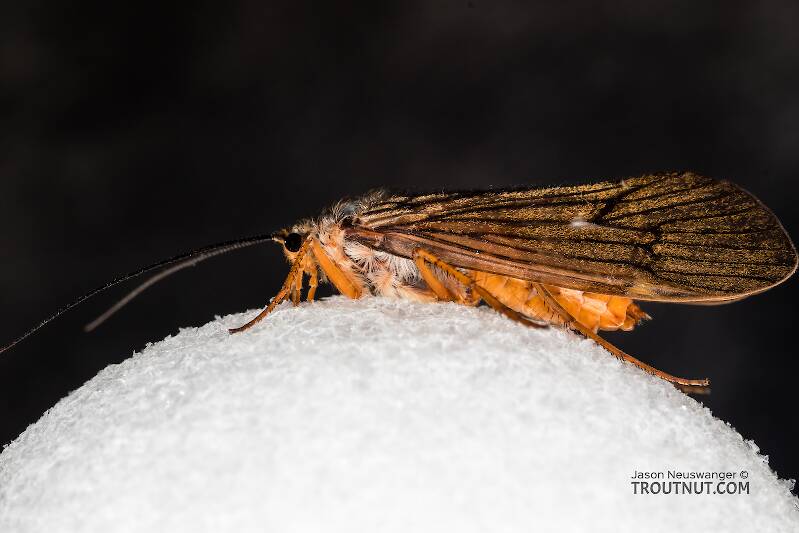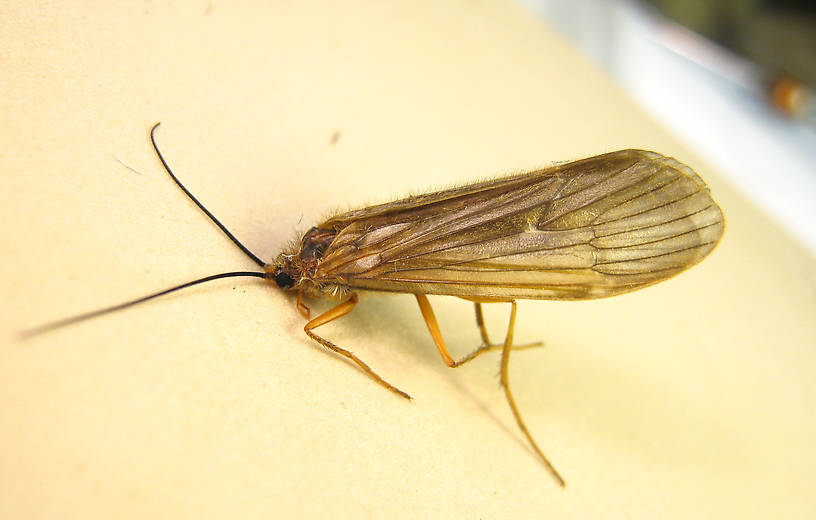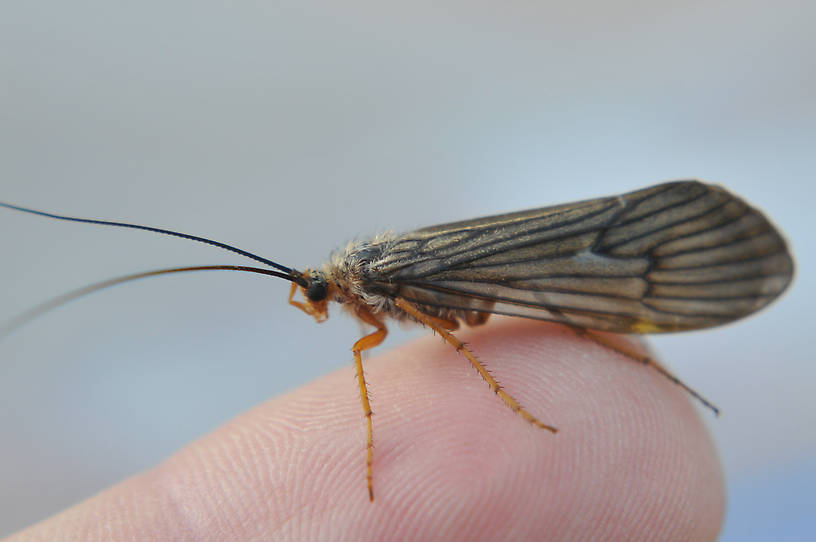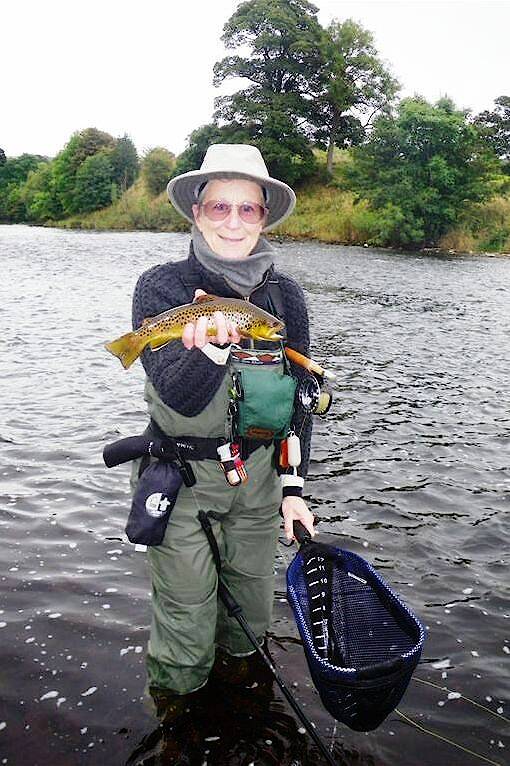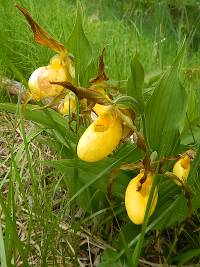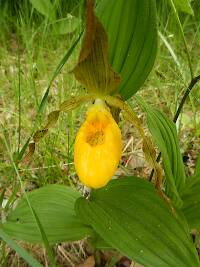
Hex Mayflies
Hexagenia limbata
The famous nocturnal Hex hatch of the Midwest (and a few other lucky locations) stirs to the surface mythically large brown trout that only touch streamers for the rest of the year.
Featured on the forum

This dun emerged from a mature nymph on my desk. Unfortunately its wings didn't perfectly dry out.

Troutnut is a project started in 2003 by salmonid ecologist Jason "Troutnut" Neuswanger to help anglers and
fly tyers unabashedly embrace the entomological side of the sport. Learn more about Troutnut or
support the project for an enhanced experience here.
This topic is about the Caddisfly Genus Dicosmoecus
This is a superhatch in the West. Gary LaFontaine had a self-proclaimed obsession with Dicosmoecus, and he devotes several pages of Caddisflies to stressing the importance of its larvae, pupae, and adults. He wrote:The question for fly fishermen seeking big trout is: "Which insects provide the best opportunity for catching such fish?" My list would be: Giant Orange Sedge (Dicosmoecus sp.), Salmon Fly (Pteronarcys californica, a stonefly), and the Michigan Mayfly (Hexagenia limbata). Dicosmoecus is the most important -- and the contest is not even close.
His reasons for this judgement are five traits of Dicosmoecus:
- Very large size: Adults 30mm long, and thick.
- Activity concentrated within 2-3 weeks.
- Emerges in the low, clear water of fall.
- Active during afternoon and evening.
- Abundant in rivers with sea-run trout.
Personally I have only caught a good Dicosmoecus hatch one time, and on a secret desert spring creek. It reminded me of fishing Isonychia mayfly hatches back east, because there weren't enough bugs around to have trout rising consistently, but the presence of a particularly good food source in low numbers for a long time had them on the lookout for imitations. I had big trout cartwheeling out of the water to smash actively-fished imitations.
Example specimens
Taxon on Jul 29, 2006July 29th, 2006, 10:23 am EDT
Jason-
In the Pacific NW, Dicosmoecus are generally referred to as either October Caddis or Fall Caddis. The field guide I generally recommend for western fly fishers is Hatch Guide For Western Streams by Jim Schollmeyer. This is what he has to say about Dicosmoecus pupae, and I believe it clarifies any ambiguity of the passage you quoted from Caddisflies:
In the Pacific NW, Dicosmoecus are generally referred to as either October Caddis or Fall Caddis. The field guide I generally recommend for western fly fishers is Hatch Guide For Western Streams by Jim Schollmeyer. This is what he has to say about Dicosmoecus pupae, and I believe it clarifies any ambiguity of the passage you quoted from Caddisflies:
In the early or mid summer, the larvae reach maturity and move from the faster currents to the slower flows that are generally found along the margins of the stream. Then they attach their cases to the rocks, seal themselves inside, and begin pupation. This transformation takes about two months. When the pupae are ready to emerge anytime between late afternoon and dark, they chew open the front of their cases and swim or crawl to the surface. The ones that find exposed rocks cling to them close to or just above the waterline; their pupal shucks split open and the adults emerge. Larvae that took refuge and pupated behind unexposed mid-stream rocks pupate and emerge in the open water. Most pupae emerge from waters that are too shallow or too exposed for trout. Any pupae that emerge in deep or open waters are vulnerable as they swim to shore or the surface.
Troutnut on Jul 29, 2006July 29th, 2006, 10:33 am EDT
Thanks. I'll update the article accordingly and look into getting that book (and Hughes/Hafele's) when I've got some more time to devote to Western hatches.
Jason Neuswanger, Ph.D.
Troutnut and salmonid ecologist
Troutnut and salmonid ecologist
Upnorth2 on Aug 18, 2006August 18th, 2006, 3:24 pm EDT
This is very important to anyone who has fished sea-run fish, like Cutts for sure. Use the swimming stage.
CaseyP on Sep 4, 2008September 4th, 2008, 6:53 am EDT
okay, this is the third time this year i've had this question, so until i can get hold of Schollmeyer's book, can one of you gentlemen tell me sizes and colors for these flies? i'm tying before we go to OR at the end of the month. thanks!
"You can observe a lot by watching." Yogi Berra
Taxon on Sep 4, 2008September 4th, 2008, 9:38 am EDT
Casey-
Jim Schollmeyer's hook size recommendations for October (Fall) Caddis are as follows:
Larvae: #6 - #10, 3xLong
Pupae: #8, 3xLong
Adult: #6 - #8
Jim Schollmeyer's hook size recommendations for October (Fall) Caddis are as follows:
Larvae: #6 - #10, 3xLong
Pupae: #8, 3xLong
Adult: #6 - #8
Trtklr on Sep 4, 2008September 4th, 2008, 1:28 pm EDT
those seem huge! should that be my size here in Michigan?
I have seen nothing more beautiful than the sunrise on a cold stream.
CaseyP on Sep 4, 2008September 4th, 2008, 3:17 pm EDT
oh, at last a use for all those larger hooks i seem to have accumulated. thank you, sir!
i've discovered the adults are orange. any advice for the pupae? we use a lot of peacock herl and a red tag over this way.
i've discovered the adults are orange. any advice for the pupae? we use a lot of peacock herl and a red tag over this way.
"You can observe a lot by watching." Yogi Berra
Taxon on Sep 4, 2008September 4th, 2008, 5:49 pm EDT
Trkler-
October Caddis or Fall Caddis is the common name for a genus of caddisflies, Dicosmoecus. There are (4) N. American species in this genus, D. atripes, D. gilvipes, D. obscuripennis, and D. pallicornis. However, they are limited to western distribution, i.e. not present in Michigan.
those seem huge! should that be my size here in Michigan?
October Caddis or Fall Caddis is the common name for a genus of caddisflies, Dicosmoecus. There are (4) N. American species in this genus, D. atripes, D. gilvipes, D. obscuripennis, and D. pallicornis. However, they are limited to western distribution, i.e. not present in Michigan.
Taxon on Sep 4, 2008September 4th, 2008, 6:00 pm EDT
Casey-
Dicosmoecus pupae are orange with brown occupying (approximately) the anterior 3/4 of the dorsal surface of each abdominal segment, and with brown wing cases.
i've discovered the adults are orange. any advice for the pupae?
Dicosmoecus pupae are orange with brown occupying (approximately) the anterior 3/4 of the dorsal surface of each abdominal segment, and with brown wing cases.
Trtklr on Sep 5, 2008September 5th, 2008, 3:58 am EDT
ok that explains it. I know we have a late year caddis hatch I have no idea what type it is though. I just know last year around this time a friend and I were on a river and just slayed em during a hatch.
I have seen nothing more beautiful than the sunrise on a cold stream.
CaseyP on Sep 5, 2008September 5th, 2008, 7:52 am EDT
thank you Roger! that is wonderfully specific. i even understand it now that i've been reading all you guy's stuff on this great site. you are all neat teachers.
i have a cat with exactly the right sort of orange and brown fur in different places. Best Fishing Buddy complains when our cats look moth-eaten, but hey, it's the right stuff for sub-surface applications and it's free!
or maybe just some Sharpie on the orange cat fur? stay tuned.
i have a cat with exactly the right sort of orange and brown fur in different places. Best Fishing Buddy complains when our cats look moth-eaten, but hey, it's the right stuff for sub-surface applications and it's free!
or maybe just some Sharpie on the orange cat fur? stay tuned.
"You can observe a lot by watching." Yogi Berra
Martinlf on Sep 6, 2008September 6th, 2008, 3:22 pm EDT
Casey, those fine tined cat brushes take the loose underfur right out without trimming. You get dubbing and the feline gets fewer hairballs. :)
"He spread them a yard and a half. 'And every one that got away is this big.'"
--Fred Chappell
--Fred Chappell
GONZO on Sep 9, 2008September 9th, 2008, 8:54 am EDT
Casey,
Although emerging Dicosmoecus usually do have orangish bodies and legs, the wings of the big adults tend to become rather dark (brownish to nearly black). As for the pupae, it is worth remembering that what we call a "pupa" is really an adult with the wings folded up and enclosed within a translucent skin. This means that we can usually determine the proper color of a caddisfly pupa by knowing (or looking at) the color of the body of freshly emerged adults. (This is unlike most mayflies where the nymphal shuck often retains a considerable amount of dark pigmentation.) The catch is that most caddisfly adults darken considerably as they age, and mating or egg-laying adults can be poor examples for determining the color of the pupae.
Scott (Trtklr),
As Roger points out, Dicosmoecus is a Western caddisfly. However, Eastern/Midwestern anglers sometimes (mis)apply the name "October caddis" to the common large caddisflies of Pycnopsyche. Like Dicosmoecus, these are large fall-emerging limnephilids. They have orangish or pumpkin-colored wings, usually with fairly distinctive dark markings. For general applications, a decent imitation of a Dicosmoecus pupa would probably work for Pycnopsyche, and vice versa. Pycnopsyche is slightly smaller, so #8-10 hooks are about right.
i've discovered the adults are orange. any advice for the pupae?
Although emerging Dicosmoecus usually do have orangish bodies and legs, the wings of the big adults tend to become rather dark (brownish to nearly black). As for the pupae, it is worth remembering that what we call a "pupa" is really an adult with the wings folded up and enclosed within a translucent skin. This means that we can usually determine the proper color of a caddisfly pupa by knowing (or looking at) the color of the body of freshly emerged adults. (This is unlike most mayflies where the nymphal shuck often retains a considerable amount of dark pigmentation.) The catch is that most caddisfly adults darken considerably as they age, and mating or egg-laying adults can be poor examples for determining the color of the pupae.
Scott (Trtklr),
As Roger points out, Dicosmoecus is a Western caddisfly. However, Eastern/Midwestern anglers sometimes (mis)apply the name "October caddis" to the common large caddisflies of Pycnopsyche. Like Dicosmoecus, these are large fall-emerging limnephilids. They have orangish or pumpkin-colored wings, usually with fairly distinctive dark markings. For general applications, a decent imitation of a Dicosmoecus pupa would probably work for Pycnopsyche, and vice versa. Pycnopsyche is slightly smaller, so #8-10 hooks are about right.
CaseyP on Sep 9, 2008September 9th, 2008, 9:19 am EDT
Gonzo,
thanks for the tip on the wing color. my friendship with the taxidermist will come in handy if i can't make something out of those turkey feathers that have been hanging around. hmm--cat fur + turkey feathers + pheasant tail legs. gotta love home-tied flies!
thanks for the tip on the wing color. my friendship with the taxidermist will come in handy if i can't make something out of those turkey feathers that have been hanging around. hmm--cat fur + turkey feathers + pheasant tail legs. gotta love home-tied flies!
"You can observe a lot by watching." Yogi Berra
Bmchenry on Oct 3, 2008October 3rd, 2008, 4:26 am EDT
The largest SRC I ever caught was on an october caddis wing-up skater tied on a size 4 long shank down-eye hook (I don't remember the exact model #/maker). Drifted it right over where I had seen the trout sipping for more than an hour as I worked my way down the pool. He ended up being 24" and a little more than 5 1/2 pounds. this was the last weekend of Septembet 2005 on the Main Fork of the Stillaguamish in Snohomish County Washington.
There are many good patterns online for october caddis and also many places, like the fly shop http://www.flyshop.com/ where you can buy some of the patterns. Easy substitutes are the sofa pillow or stimulator in orange size 4-6.
My absolute favorite go-to fall fly would be the tied back caddis which is an october caddis variant with a very thick wing tied back at the beginning of the hook bend. I don't know why but this profile seems to be preferred among trout of the freestone streams in western washington.
There are many good patterns online for october caddis and also many places, like the fly shop http://www.flyshop.com/ where you can buy some of the patterns. Easy substitutes are the sofa pillow or stimulator in orange size 4-6.
My absolute favorite go-to fall fly would be the tied back caddis which is an october caddis variant with a very thick wing tied back at the beginning of the hook bend. I don't know why but this profile seems to be preferred among trout of the freestone streams in western washington.
Bmchenry on Oct 3, 2008October 3rd, 2008, 4:37 am EDT
One more page that has a good representation of October Caddis fly patterns: http://www.flyfishusa.com/flies/caddis-giant.htm
this one also has an example of the tied-back caddis I was referring to before. It's an old pattern not much seen but it really works well!
this one also has an example of the tied-back caddis I was referring to before. It's an old pattern not much seen but it really works well!
GONZO on Oct 3, 2008October 3rd, 2008, 7:35 am EDT
Brandon,
Thanks for contributing to this discussion. (And congrats on that spectacular sea-run cutt!) The images on the flyfish USA site are nice, so here's a link for convenience:
http://www.flyfishusa.com/flies/caddis-giant.htm
There are some additional images (I particularly like the underwater shot of the live pupa) on this site:
http://www.westfly.com/entomology/caddis/october.shtml
As indicated earlier, there are similarities (from a fly-fishing standpoint) between Western Dicosmoecus and Eastern Pycnopsyche. Their emergence habits are very similar, and many of the adult or pupal patterns will serve to imitate either caddisfly adequately with only a size adjustment. For my fellow Easterners, images of the Great Brown Autumn Sedge/Giant Red Sedge can be found here:
http://bugguide.net/node/view/85436/bgimage
Thanks for contributing to this discussion. (And congrats on that spectacular sea-run cutt!) The images on the flyfish USA site are nice, so here's a link for convenience:
http://www.flyfishusa.com/flies/caddis-giant.htm
There are some additional images (I particularly like the underwater shot of the live pupa) on this site:
http://www.westfly.com/entomology/caddis/october.shtml
As indicated earlier, there are similarities (from a fly-fishing standpoint) between Western Dicosmoecus and Eastern Pycnopsyche. Their emergence habits are very similar, and many of the adult or pupal patterns will serve to imitate either caddisfly adequately with only a size adjustment. For my fellow Easterners, images of the Great Brown Autumn Sedge/Giant Red Sedge can be found here:
http://bugguide.net/node/view/85436/bgimage
CaseyP on Oct 3, 2008October 3rd, 2008, 11:57 am EDT
back from the trip that started this thread, and have to report that one (ONE-UNO-EIN-UN-WAHID-EYK) October caddis made its presence known to us as we fished three different rivers. the weather was clear, dry, and warm, so nothing bothered to hatch, unlike last year when Best Fishing Buddy froze in the autumn rains and sleet and got lost in clouds of bugs.
that's why they call it weather...
anyhow, funny thing: this big brown bug comes lalolloping along over the water just ahead of my orange stimulator that was indicating a couple of nymphs. sure enough, the fish struck the stimi, but not very hard and not so as to actually stick to the hook. just the one bug, and just the one strike.
that's why it's called fishing...wait 'til next year! ;-)
meanwhile, thanks to all of you for your patient assistance. without troutnut.com my fishing universe would be barren indeed!
p.s. found a copy of the Hatch Guide For Western Streams and this time i bought it.
that's why they call it weather...
anyhow, funny thing: this big brown bug comes lalolloping along over the water just ahead of my orange stimulator that was indicating a couple of nymphs. sure enough, the fish struck the stimi, but not very hard and not so as to actually stick to the hook. just the one bug, and just the one strike.
that's why it's called fishing...wait 'til next year! ;-)
meanwhile, thanks to all of you for your patient assistance. without troutnut.com my fishing universe would be barren indeed!
p.s. found a copy of the Hatch Guide For Western Streams and this time i bought it.
"You can observe a lot by watching." Yogi Berra
GONZO on Oct 4, 2008October 4th, 2008, 4:22 am EDT
Casey, your experience reminds me of a favorite line from Little Big Man: "Well, sometimes the magic works...."
Jack_k on Oct 24, 2008October 24th, 2008, 6:35 pm EDT
There's a pretty good picture of an adult October Caddis on my website. We were up near Burney, Ca. They were doing a Kamakazi number on the water, ovipositing it appeared. I snagged this one with my hat as he blew by. I prefer tying this on a 10 or 12 3x limmerick, orange foam body, long Elk mane for a wing, and a dab of yellow foam on the butt to simulate an egg packet.
I'm just getting retired after 40 some years as a Medical Technologist. It's great to read all the posts, Jason has the most unique site on the web. It's great to know the folks coming up behind me still have the fever.
Jack_K Just2ty4.com
I'm just getting retired after 40 some years as a Medical Technologist. It's great to read all the posts, Jason has the most unique site on the web. It's great to know the folks coming up behind me still have the fever.
Jack_K Just2ty4.com
Quick Reply
Related Discussions
Topic
Replies
Last Reply
2
Sep 20, 2020
by Creno
by Creno
Re: You Western anglers - any experience with the Giant Orange Sedges?
In the Caddisfly Genus Dicosmoecus by Troutnut
In the Caddisfly Genus Dicosmoecus by Troutnut
7
Jan 7, 2009
by Dgracia
by Dgracia
14
Sep 26, 2013
by Crepuscular
by Crepuscular
0
May 25, 2012
by Jmd123
by Jmd123


